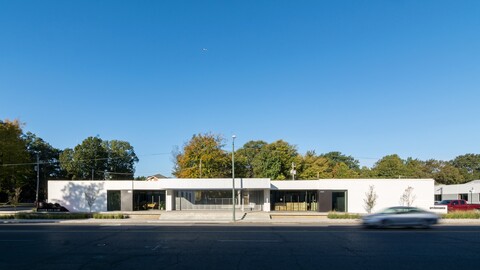News Brief
Industry Aligns on Federal Zero-Emissions-Building Definition
Living Future intends to align its Zero Carbon and Living Building certifications with the new federal definition of a “zero-emissions building.” Archimania’s office in Memphis, Tennessee, pictured above, achieved the former.
The definition is not a standard, and the government doesn’t plan to adjudicate whether a particular project fits the definition, the Biden administration makes clear. Instead, it intends for other organizations—within the government and elsewhere—to use the definition as a basis for their own standards and criteria.
What’s in the definition?
The definition, which the U.S. Department of Energy published as the “National Definition of a Zero Emissions Building: Part 1: Operational Emissions from Energy Use, Version 1,” is relatively simple and includes just three requirements. In a nutshell, a zero-emissions building must:
- be energy efficient: existing buildings must have an Energy Star score of at least 75 and a new buildings score of at least 90 or 10% better than the model code.
- not emit any greenhouse gases directly, such as from burning fossil fuels onsite. (Burning fuels onsite for backup power is allowed.)
- be powered entirely by “clean energy” with no associated greenhouse gas emissions from onsite or offsite sources.
Embodied carbon and refrigerants are not currently included in the definition, but work is underway to address them in a forthcoming part two. Their inclusion would better align this definition with international standards, such as the newly published Pilot Version of the UK Net Zero Carbon Buildings Standard.
Who’s lining up behind it?
At September’s Climate Week New York City, nine green building standard-setting organizations announced their intent to align with this definition. The U.S. Green Building Council, for one, seems to be on track towards alignment after the second public comment draft of LEED version 5. With the new “Platinum-level requirements” in LEED v5, LEED for New Construction projects certified at the Platinum should be consistent with the definition. LEED for Operations and Maintenance, however, stops short of requiring existing buildings to be zero emissions, even at the Platinum level.
Living Future with its Zero Carbon and Living Building certifications, and both Passive House organizations voiced their intent to align with the definition, too.
Other organizations also expressed support, including ASHRAE, the American Institute of Architects, the Urban Land Institute, Architecture 2030, and New Buildings Institute.
More on zero-emissions buildings
White House to Release Building Decarbonization Standard
Yay, Your Building Is Net Zero! Meaning … What Exactly?
For more information:
U.S. Department of Energy
energy.gov
Published October 28, 2024 Permalink Citation
Malin, N. (2024, October 28). Industry Aligns on Federal Zero-Emissions-Building Definition. Retrieved from https://www.buildinggreen.com/newsbrief/industry-aligns-federal-zero-emissions-building-definition



Add new comment
To post a comment, you need to register for a BuildingGreen Basic membership (free) or login to your existing profile.